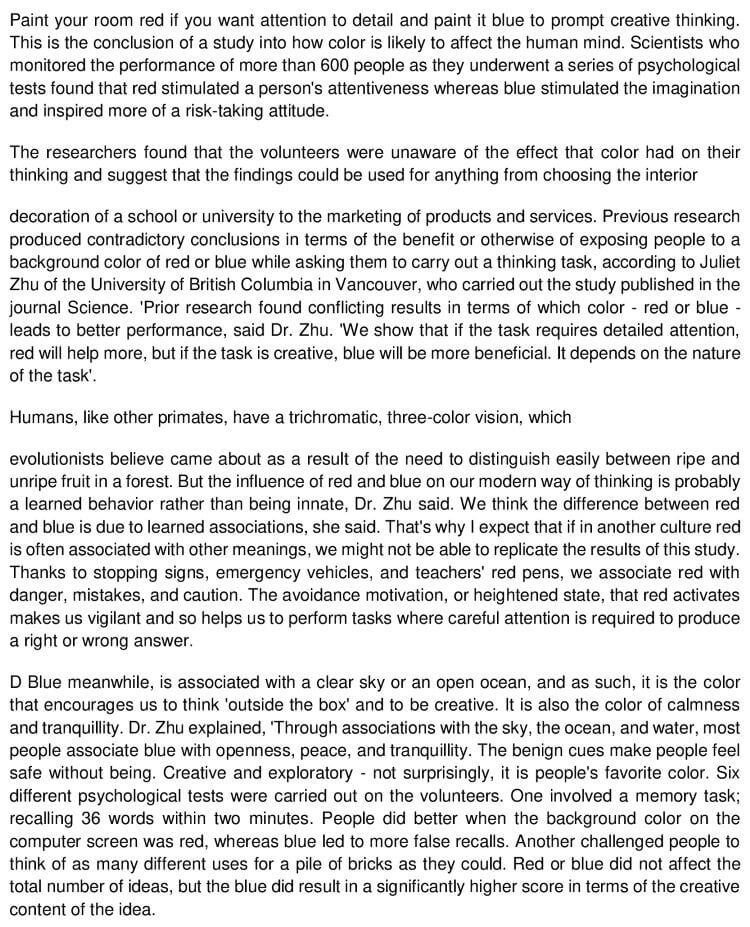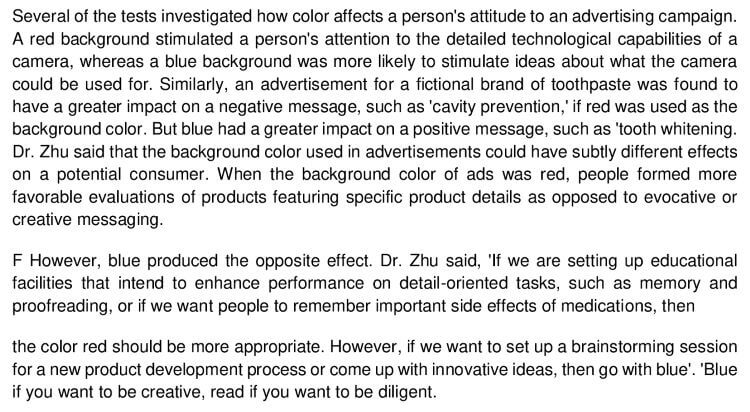Color on the Brain- IELTS Reading Answer
8 min read
Updated On
-
Copy link
Table of Contents

Limited-Time Offer : Access a FREE 10-Day IELTS Study Plan!
The ‘Colour on the Brain‘ is an IELTS Academic Reading passage that helps prepare for the IELTS Reading test. It shows the types of passages and questions you’ll encounter. Review the “Colour on the Brain” answers to understand the question types and difficulty level. This IELTS Reading passage includes 13 questions with different question types:
- Summary Completion(Q. 14-21)
- Matching Features(Q. 22-27)
Reading Passage
| You should spend about 20 minutes on Questions 14-27 which are based on the Reading Passage below. |
Color on the Brain
A scientific study reveals the different effects that colors have on the brain


Questions 14-21
Complete the summary using the list of words, A-L, below.
Write the correct letter, A-Lin boxes 14-21 on your answer sheet.
A recent study has found that the color red can encourage people to produce 14 ………. work and blue can make people 15 ………. to take risks. Researchers conducted tests on volunteers to find out whether cognitive performance 16 ……… . when people saw red or blue. The volunteers performed a series of tasks with words or images displayed against red or blue backgrounds on computer screens. Red groups were 17 ………. in tests of memory. They performed 18………. on tests that required more creative responses, such as inventing different uses for a pile of bricks. Blue groups produced 19 ………. ideas. The study also tested responses to advertising and found that advertisements that listed product details were 20 ………. with the volunteers when displayed on red backgrounds. Advertisements that used imaginative designs were 21 ………. than those displayed on blue backgrounds.
- more successful
- more detailed
- less well
- actually
- increased
- more effective
- more appropriate
- more popular
- varied
- more likely
- more original
- less appealing
Questions 22-26
Classify the following statements as referring to
A red
B blue
Write the correct letter A or Bin boxes 22-26 on your answer sheet.
22 It may help people recall information more easily.
23 It may encourage people to experiment with ideas.
24 It may enable people to avoid dangerous situations.
25 It may make people less wary about taking risks.
26 It may enable people to concentrate more easily.
Color on the Brain IELTS Reading Answers
Here’s a detailed explanation of answers for the Color on the Brain IELTS Reading Passage:
14 Answer: B
Question type: Summary Completion
Answer location: Paragraph B, last line
Answer explanation: The last line of paragraph B states that if the task requires detailed attention, red will help more, but if the task is creative, blue will be more beneficial. These lines illustrate that a recent study has found that the color red can encourage people to produce more detailed work. Thus, the answer is B.
15 Answer: J
Question type: Summary Completion
Answer location: Paragraph A, last line
Answer explanation: The last line of paragraph A reveals that blue stimulated the imagination and inspired more of a risk-taking attitude. As a result, blue can make people more likely to take risks. Thus, the answer is J.
16 Answer: I
Question type: Summary Completion
Answer location: Paragraph A, last line
Answer explanation: The last line of paragraph A states that Scientists who monitored the performance of more than 600 people as they underwent a series of psychological tests found that red stimulated a person’s attentiveness whereas blue stimulated the imagination and inspired more of a risk-taking attitude. These lines indicate that scientists monitored the performance of 600 people who underwent a series of psychological tests. These tests were conducted to find out if the cognitive performance varied when people saw red or blue. Thus, the answer is I.
17 Answer: A
Question type: Summary Completion
Answer location: Paragraph D, line 7
Answer explanation: In the 7th line of paragraph D, it is mentioned that one involved a memory task; recalling 36 words within two minutes. People did better when the background color on the computer screen was red. These lines reveal that a memory task was conducted and people with a red background on the computer screen performed better. Thus, the answer is A.
18 Answer: C
Question type: Summary Completion
Answer location: Paragraph D, last line
Answer explanation: The last line of paragraph D illustrates another challenged people to think of as many different uses for a pile of bricks as they could. Red or blue did not affect the total number of ideas, but the blue did result in a significantly higher score in terms of the creative content of the idea. These lines indicate that people with a red background performed less well on tests that required more creative responses, such as inventing different uses for a pile of bricks. Thus, the answer is C.
19 Answer: K
Question type: Summary Completion
Answer location: Paragraph F, line 5
Answer explanation: The 5th line of paragraph F states that if we want to set up a brainstorming session for a new product; development process or coming up with innovative ideas, then go with blue’. ‘Blue if you want to be creative, read if you want to be diligent. These lines suggest that blue groups came up with innovative or more original ideas. Hence, the answer is K.
20 Answer: H
Question type: Summary Completion
Answer location: Paragraph E, line 4
Answer explanation: The 4th line of paragraph E states that an advertisement for a fictional brand of toothpaste was found to have a greater impact on a negative message, such as ‘cavity prevention,’ if red was used as the background color. These lines suggest that red had a greater impact on a negative message in the advertisement. For instance, red was used for cavity prevention in an ad for a toothpaste brand. Hence, it is evident that details were more popular with the volunteers when the ad was displayed on a red background. Therefore, the answer is H.
21 Answer: L
Question type: Summary Completion
Answer location: Paragraph F
Answer explanation: The initial lines of paragraph F states that blue produced the opposite effect, which means that the advertisement which used imaginative designs were less appealing than those displayed on blue background. Thus, the answer is L.
22 Answer: A
Question type: Matching Features
Answer location: Paragraph B, line 8
Answer explanation: The 8th line of paragraph B states that Dr. Zhu said that if the task requires detailed attention, red will help more, but if the task is creative, blue will be more beneficial. These lines indicate that red will be more helpful to detail attention whereas blue will be beneficial if the task is creative. Thus, the answer is A.
23 Answer: B
Question type: Matching Features
Answer location: Paragraph A, last line
Answer explanation: The last line of paragraph A states that blue stimulated the imagination and inspired more of a risk-taking attitude. We can understand from these lines that the blue background stimulates the imagination and inspires more of a risk-taking attitude. As a result, it may make people less wary about taking risks. Thus, the answer is B.
24 Answer: A
Question type: Matching Features
Answer location: Paragraph C, line 7
Answer explanation: The 7th line of paragraph C states, “Thanks to stopping signs, emergency vehicles, and teacher’s red pens, we associate red with danger, mistakes, and caution.” These lines indicate that red is associated with danger, mistake, and caution. As a result, red enables people to avoid dangerous situations. Thus, the answer is A.
25 Answer: B
Question type: Matching Features
Answer location: Paragraph D, last line
Answer explanation: The last line of paragraph D reveals that red or blue did not affect the total number of ideas, but the blue did result in a significantly higher score in terms of the creative content of the idea. These lines suggest that it wasn’t a matter of red or blue, however, blue scored higher in terms of creativity and ideas. Further, the 3rd line of paragraph E states that a blue background was more likely to stimulate ideas. As a result, the blue background encouraged people to experiment with ideas. Thus, the answer is B.
26 Answer: A
Question type: Matching Features
Answer location: Paragraph D, line 7
Answer explanation: The 7th line of paragraph D states that people did better when the background colour on the computer screen was red, whereas blue led to more false recalls. These lines indicate that when the background color on the computer screen was red, it helped people recall information more easily. Thus, the answer is A.
Tips to Solve the Passage Question Types in the Color on the Brain Reading Answers
Since now you know the answers to ‘How Animals Keep Fit’ Reading Answers, let us check out some quick IELTS General Training Reading tips to answer the passage question types in the Reading Answers of How Animals Keep Fit Reading Answers.
Summary Completion:
Summary Completion is a type of reading question in IELTS exam that requires you to fill in a gap in a paragraph with a word or phrase from the passage.
To answer summary completion questions, you can use the following strategies:
- Reading the sentences carefully will give you an idea of the type of word or phrase that is missing.
- Next, scan the passage for the keywords. The keywords in the sentence can help you to identify the correct word or phrase.
- Read the sentence with the missing word or phrase. It will help you to see how the word or phrase fits into the sentence.
- Finally, check your answer. Once you have filled in the gap, make sure that your answer makes sense in the context of the sentence.
Matching Features
Matching Features questions require test takers to match a set of statements or pieces of information to a list of options (features). The options might include names, dates, places, or any other categories given in the passage.
- Read Instructions Carefully: Understand what type of information you need to match (e.g., names, dates, places).
- Identify Keywords: Highlight keywords in the statements and options to locate them in the passage.
- Skim and Scan the Passage: Skim for general structure and scan for specific keywords related to the options.
- Understand the Context: Read around the keywords to understand the context and ensure the correct match.
- Eliminate Incorrect Options: Use the process of elimination for options that clearly do not match the statements.
Check More IELTS Reading Answers
Also Check:
Practice IELTS Reading based on question types

Start Preparing for IELTS: Get Your 10-Day Study Plan Today!
Recent Articles

Nehasri Ravishenbagam

Haniya Yashfeen

Haniya Yashfeen

Haniya Yashfeen




Post your Comments